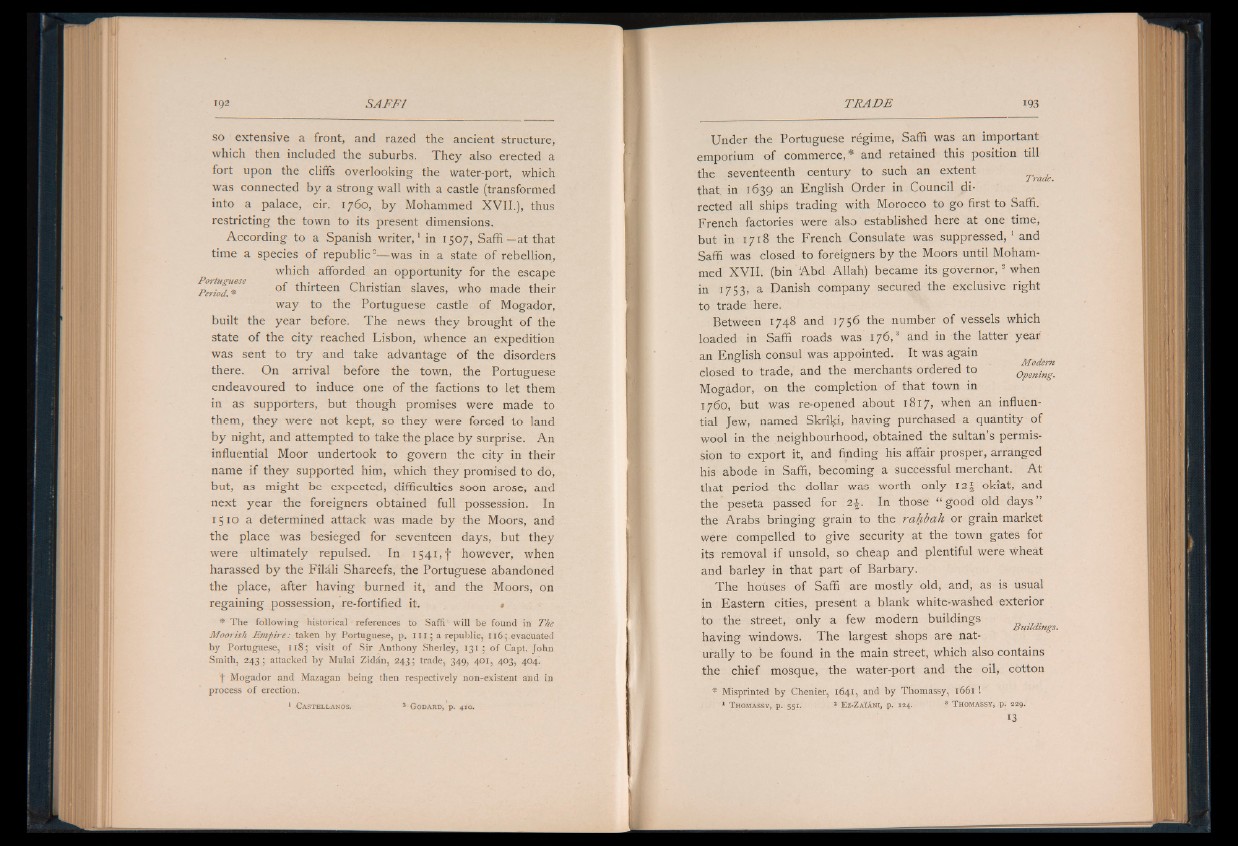
so extensive a front, and razed the ancient structure,
which then included the suburbs. They also erected a
fort upon the cliffs overlooking the water-port, which
was connected by a strong wall with a castle (transformed
into a palace, cir. 1760, by Mohammed XVII.), thus
restricting the town to its present dimensions.
According to a Spanish writer,1 in 1507, Saffi— at that
time a species of republic2— was in a state of rebellion,
which afforded an opportunity for the escape
Povtu PlteS6 • |
Period* thirteen Christian slaves, who made their
way to the Portuguese castle of Mogador,
built the year before. The news they brought of the
state of the city reached Lisbon, whence an expedition
was sent to try and take advantage of the disorders
there. On arrival before the town, the Portuguese
endeavoured to induce one of the factions to let them
in as supporters, but though promises were made to
them, they were not kept, so they were forced to land
by night, and attempted to take the place by surprise. An
influential Moor undertook to govern the city in their
name if they supported him, which they promised to do,
but, as might be expected, difficulties soon arose, and
next year the foreigners obtained full possession. In
1510 a determined attack was made by the Moors, and
the place was besieged for seventeen days, but they
were ultimately repulsed. In I 5 4 i ,f however, when
harassed by the Filali Shareefs, the Portuguese abandoned
the place, after having burned it, and the Moors, on
regaining possession, re-fortified it.
* The following historical references to Saffi' will be found in The
Moorish Em fire: taken by Portuguese, p. 1 1 1 ; a republic, 116; evacuated
by Portuguese, i iS ; visit of Sir Anthony Sherley, 131 ; of Capt. John
Smith, 243; attacked by Mulai Zidan, 243; trade, 349, 401, 403, 404.
f Mogador and Mazagan being then respectively non-existent and in
process of erection.
1 C a s t e l l a n o s . 2 G o d a r d , p . 4x0.
Under the Portuguese régime, Saffi was an important
emporium of commerce,* and retained this position till
the seventeenth century to such an extent Trade
that, in 1639 an English Order in Council directed
all ships trading with Morocco to go first to Saffi.
French factories were also established here at one time,
but in 1718 the French Consulate was suppressed,1 and
Saffi was closed to foreigners by the Moors until Mohammed
XVII. (bin Abd Allah) became its governor,3 when
in 1753, a Danish company secured the exclusive right
to trade here.
Between 1748 and 1756 the number of vessels which
loaded in Saffi roads was 176,3 and in the latter year
an English consul was appointed. It was again Modem
closed to trade, and the merchants ordered to opening.
Mogador, on the completion of that town in
1760, but was re-opened about 1817, when an influential
Jew, named Skriki, having purchased a quantity of
wool in the neighbourhood, obtained the sultan’s permission
to export it, and finding his affair prosper, arranged
his abode in Saffi, becoming a successful merchant. A t
that period the dollar was worth only 12\ okiat, and
the peseta passed for 2\. In those “ good old d a y s ”
the Arabs bringing grain to the rahbah or grain market
were compelled to give security at the town gates for
its removal if unsold, so cheap and plentiful were wheat
and barley in that part of Barbary.
The hoûses of Saffi are mostly old, and, as is usual
in Eastern cities, present a blank white-washed exterior
to the street, only a few modern buildings
I Bmlaings.
having windows. The largest shops are naturally
to be found in the main street, which also contains
the chief mosque, the water-port and the oil, cotton
* Misprinted by Chenier, 1641, and by Thomassy, 1661 !
1 T h o m a s s y , p . 55 1 . 1 E z -Z a ïà n i , p . 124. 3 T h o m a s s y , p . 229. 13